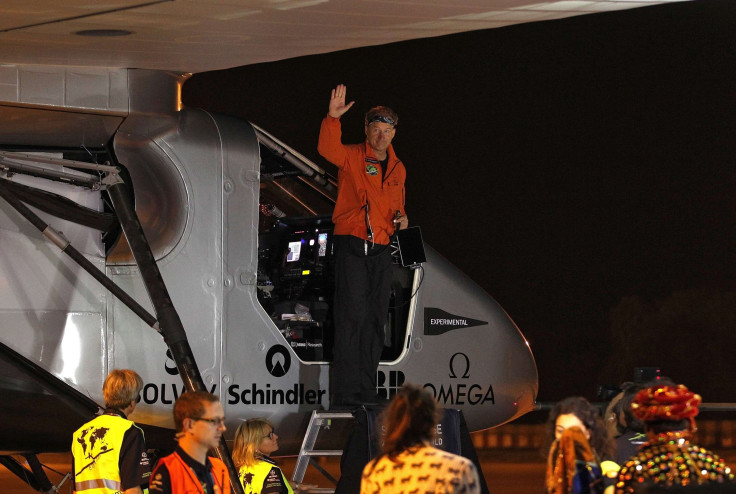Solar Impulse-2 Takes Off From Indian City Of Ahmedabad After Bureaucratic Snafu

Solar Impulse-2, a solar-powered plane attempting to circumnavigate the globe, took off from the western Indian city of Ahmedabad on Wednesday after being delayed by bad weather and paperwork. The plane, piloted by Swiss businessman André Borschberg and his compatriot Bertrand Piccard, is now headed to the Indian city of Varanasi.
“If there is no adventure in the future, it is not because of a lack of ideas, but because of excessive administration,” Piccard wrote on Twitter early on Wednesday, blaming Indian bureaucracy for delaying immigration clearance. The plane, which started its ambitious journey from Abu Dhabi on March 9, landed in Ahmedabad -- located in Indian Prime Minister Narendra Modi’s home state of Gujarat -- last Tuesday, and was originally scheduled to depart on Sunday.
“The delay is (because of) of administration, papers, stamps,” Piccard reportedly said, before taking off from Ahmedabad. “I'm not here to accuse anybody. I just say that since the last five days we are trying to get all the stamps and every day (they) say tomorrow.”
However, Indian immigration officials reportedly blamed Piccard for failing to obtain immigration clearance on time. “Piccard was neither a VVIP (Very Very Important Person) nor a state guest, so he should have come for clearance upon his arrival,” an immigration official, whose name was not revealed, said, according to local media reports.
Before having the stamp, you are nobody. Thank you all for your support pic.twitter.com/JGhPSZxkdW
— Bertrand PICCARD (@bertrandpiccard) March 18, 2015The roughly 680 mile-journey from Ahmedabad to Varanasi is the third leg of the mission and is expected to take Borschberg about 15 hours to complete. After stopping for a few hours in Varanasi, the plane will take off to Myanmar and China, before heading across the Pacific Ocean to Hawaii. Then it will stop at Phoenix, Arizona, and New York's biggest airport, John F. Kennedy International.
The plane will then attempt to cross the Atlantic before embarking on the final leg of its flight to Abu Dhabi. The Pacific and Atlantic crossings will require Solar Impulse to fly non-stop for several days at a time.
The Swiss pilots say that the aim of the 21,747 mile-journey is to create awareness about “clean and efficient technologies." Solar Impulse-2 -- a lightweight version of the prototype Solar Impulse-1 aircraft that was first tested in 2009 -- is made entirely of carbon fiber and has a 236-foot wingspan, which is longer than that of the Boeing 747.
It is powered entirely by an array of 17,000 solar cells built into the wings that will also recharge the lithium-ion batteries the plane will use to sustain night-time flying. However, because the aircraft has an average speed of just over 43 mph, it would take the two pilots several days and nights of non-stop flying to complete the journey.
© Copyright IBTimes 2024. All rights reserved.






















